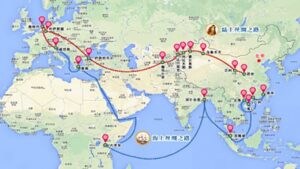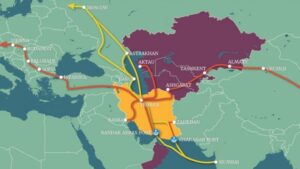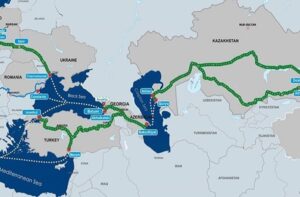
The “Crossroads of Peace” bypasses Armenia
In 2025, the construction of the most complex section of the North-South railway—which will connect the Iranian cities of Rasht and Astara—will be completed. Russia granted a $1.3 billion loan for the final implementation of this project. From the already approved official road map, it can be seen that the North-South communication corridor in the South Caucasus region will have two tracks. The first route starts in the Iranian port of Bandar Abbas and passes through Azerbaijan to Russia and Georgia, and from there to Europe via the Black Sea. The second route also starts in the port of Bandar Abbas, reaching all the way to the Caspian Sea, and from there connecting with Russian ports by sea route. In fact, it turns out that the North-South road bypasses Armenia.
- The internationally recognized route of the North-South Road
Not long ago, the person occupying the Armenian prime minister’s seat made bold statements that we would create a “Crossroads of Peace” with our Turkish neighbors in the region, thus becoming a bridge between the North and the South, the East and the West. While, in fact, the North and the South have officially been connected via Azerbaijan and the Caspian Sea, but not via Armenia. Some theorists may argue that a North-South road is being built in Armenia, which will become an important component of the North-South corridor. However, other interested parties, particularly Russia and Iran, have lost their interest in that path, because the present authorities of Armenia ceded to Azerbaijan such road sections passing through Syunik, which could become important parts of the high-speed highway. The Armenian side is still unable to create alternative, proper traffic roads that would not be blocked in winter and would be able to connect the villages of Syunik with towns and Yerevan. In the absence of these basic roads, there is no point talking about having an international transit route, by which it would be possible to transport thousands of tons of cargo in large trucks. In addition, the Armenian side continues its “genius” policy of cessions and has ceded important road sections to Azerbaijan in Kirants as well. Now, to be able to visit Georgia’s Kobuleti and other recreation areas, even Armenian citizens have to bypass the roads that have been common for a long time. With this in mind, it is pointless, and even ridiculous, to talk about major transit cargo transportation, because many road sections of strategic importance will already be controlled by Azerbaijan. Besides, it is still not clear what will be ceded to the enemy under the so-called “delimitation and demarcation” process. That is why, no one wants to cooperate with a country that has an unstable road map, and whose authorities are ready to cede control of their roads of strategic importance to the enemy state. Some may have the impression that, although Armenia has lost its importance for the North-South communication routes, it may still play an important role in terms of connecting the East to the West. Harping on about this, Pashinyan declares everywhere that Armenia should carry out an open-door policy with its neighbors, especially Azerbaijan and Turkey, so that the communications connecting the East to the West will not bypass Armenia. However, we have to disappoint those waiting for the bright future promised by Pashinyan because the two main road junctions connecting the East and the West already bypass Armenia. The first one is the famous “Silk” Road, which starts in China, passes through the Central Asian countries and Iran, and then reaches Europe via Iraq and Turkey; it completely bypasses the South Caucasus region.
Now, since Yerevan is not officially a part of the North-South road, it will be rather difficult for it to connect to this communication hub as well. The reason is that these two communication routes have common crossing points in Iran, and not being an important part of the North-South road, one cannot fully take the opportunities of the “Silk” Road either. The attached map clearly shows the common intersection points of the North-South road and the “Silk” Road.
The second most important junction connecting the East with the West is the Trans-Caspian horizontal route, which starts in Europe, passes through Turkey, Georgia and Azerbaijan to the Caspian Sea, and from there reaches China through the Central Asian countries. And as you will notice, it also bypasses Armenia.
The Pashinyan administration entertains hopes that by making unilateral concessions to Azerbaijan and Turkey, it will be possible to open the borders with these countries, to create the so-called “Middle Corridor”, and to become an additional component of the Trans-Caspian routes. With this, they would have an opportunity to conduct a PR campaign for Pashinyan. However, the Turkish-Azerbaijani statements show that the cornerstone of these countries’ strategy is not having open borders with Armenia at all, let alone making it a part of international communication routes, but to get the so-called “Zangezur Corridor” from Armenia. And, in view of the incompetent and fearful policy of the current authorities, the Turkish-Azerbaijani tandem has good chances to open that corridor and even to control it. In this case, all the opportunities—to even become a part of the Trans-Caspian routes—will be lost.
Thus, the future of the “Crossroads of Peace” promised by Pashinyan has long since bypassed Armenia. And this was to be expected, because, a government that led the country to defeat, failed the economy and doubled the external debt accumulated in 30 years by its predecessors in six years, could not address a geopolitical problem of such complexity.
Ashot Barekyan






